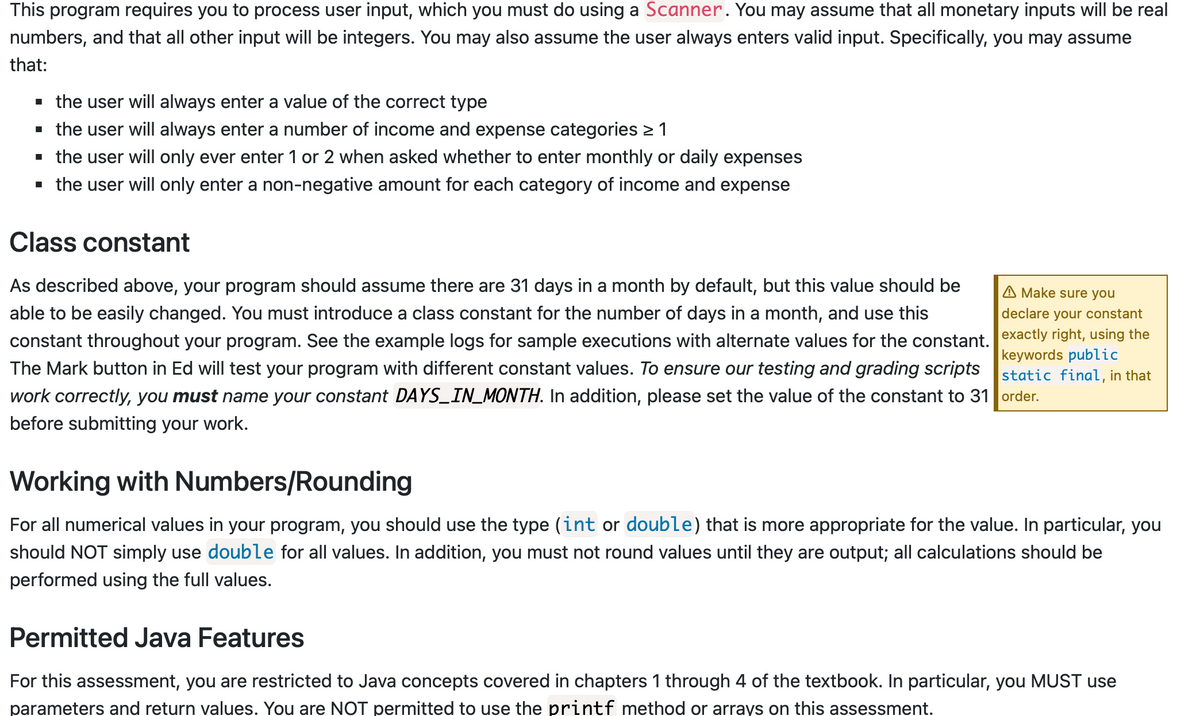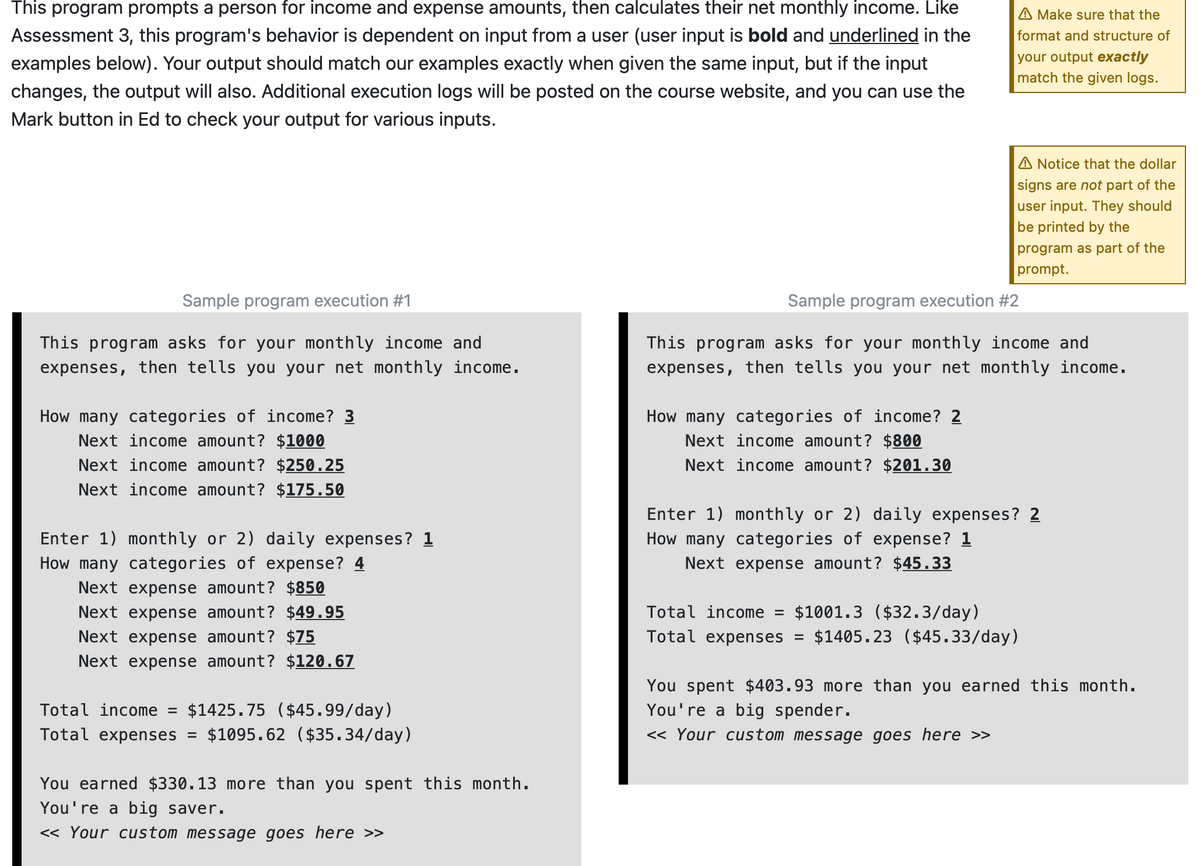This program prompts a person for income and expense amounts, then calculates their net monthly income. Like Assessment 3, this program's behavior is dependent on input from a user (user input is bold and underlined in the A Make sure that the format and structure of your output exactly match the given logs. examples below). Your output should match our examples exactly when given the same input, but if the input changes, the output will also. Additional execution logs will be posted on the course website, and you can use the Mark button in Ed to check your output for various inputs. A Notice that the dollar signs are not part of the user input. They should be printed by the program as part of the prompt. Sample program execution #1 Sample program execution #2 This program asks for your monthly income and expenses, then tells you your net monthly income. This program asks for your monthly income and expenses, then tells you your net monthly income. How many categories of income? 3 How many categories of income? 2 Next income amount? $1000 Next income amount? $800 Next income amount? $250.25 Next income amount? $201.30 Next income amount? $175.50 Enter 1) monthly or 2) daily expenses? 2 How many categories of expense? 1 Next expense amount? $45.33 Enter 1) monthly or 2) daily expenses? 1 How many categories of expense? 4 Next expense amount? $850 Total income = $1001.3 ($32.3/day) Total expenses = $1405.23 ($45.33/day) Next expense amount? $49.95 Next expense amount? $75 Next expense amount? $120.67 Total income = $1425.75 ($45.99/day) Total expenses = $1095.62 ($35.34/day) You spent $403.93 more than you earned this month. You're a big spender. « Your custom message goes here > You earned $330.13 more than you spent this month. You're a big saver. « Your custom message goes here >>
This program prompts a person for income and expense amounts, then calculates their net monthly income. Like Assessment 3, this program's behavior is dependent on input from a user (user input is bold and underlined in the A Make sure that the format and structure of your output exactly match the given logs. examples below). Your output should match our examples exactly when given the same input, but if the input changes, the output will also. Additional execution logs will be posted on the course website, and you can use the Mark button in Ed to check your output for various inputs. A Notice that the dollar signs are not part of the user input. They should be printed by the program as part of the prompt. Sample program execution #1 Sample program execution #2 This program asks for your monthly income and expenses, then tells you your net monthly income. This program asks for your monthly income and expenses, then tells you your net monthly income. How many categories of income? 3 How many categories of income? 2 Next income amount? $1000 Next income amount? $800 Next income amount? $250.25 Next income amount? $201.30 Next income amount? $175.50 Enter 1) monthly or 2) daily expenses? 2 How many categories of expense? 1 Next expense amount? $45.33 Enter 1) monthly or 2) daily expenses? 1 How many categories of expense? 4 Next expense amount? $850 Total income = $1001.3 ($32.3/day) Total expenses = $1405.23 ($45.33/day) Next expense amount? $49.95 Next expense amount? $75 Next expense amount? $120.67 Total income = $1425.75 ($45.99/day) Total expenses = $1095.62 ($35.34/day) You spent $403.93 more than you earned this month. You're a big spender. « Your custom message goes here > You earned $330.13 more than you spent this month. You're a big saver. « Your custom message goes here >>
Computer Networking: A Top-Down Approach (7th Edition)
7th Edition
ISBN:9780133594140
Author:James Kurose, Keith Ross
Publisher:James Kurose, Keith Ross
Chapter1: Computer Networks And The Internet
Section: Chapter Questions
Problem R1RQ: What is the difference between a host and an end system? List several different types of end...
Related questions
Question
I need help with this java code. I need to follow these guidelines to get this output below in the pictures. Please carefuly read and follow guidelines so the code is like how it is.
This assignment will assess your mastery of the following objectives:
- Write a functionally correct Java program to produce specified console output.
- Use conditional (if) statements to conditionally excecute code.
- Write and call methods that accept parameters and return values to manage information flow.
- Use Scanner to accept and process user input.
- Follow prescribed conventions for spacing, indentation, naming methods, and header comments.

Transcribed Image Text:This program requires you to process user input, which you must do using a Scanner. You may assume that all monetary inputs will be real
numbers, and that all other input will be integers. You may also assume the user always enters valid input. Specifically, you may assume
that:
· the user will always enter a value of the correct type
· the user will always enter a number of income and expense categories > 1
· the user will only ever enter 1 or 2 when asked whether to enter monthly or daily expenses
· the user will only enter a non-negative amount for each category of income and expense
Class constant
As described above, your program should assume there are 31 days in a month by default, but this value should be
A Make sure you
able to be easily changed. You must introduce a class constant for the number of days in a month, and use this
constant throughout your program. See the example logs for sample executions with alternate values for the constant.exactly right, using the
The Mark button in Ed will test your program with different constant values. To ensure our testing and grading scripts static final, in that
declare your constant
keywords public
work correctly, you must name your constant DAYS_IN_MONTH. In addition, please set the value of the constant to 31 order.
before submitting your work.
Working with Numbers/Rounding
For all numerical values in your program, you should use the type (int or double) that is more appropriate for the value. In particular, you
should NOT simply use double for all values. In addition, you must not round values until they are output; all calculations should be
performed using the full values.
Permitted Java Features
For this assessment, you are restricted to Java concepts covered in chapters 1 through 4 of the textbook. In particular, you MUST use
parameters and return values. You are NOT permitted to use the printf method or arrays on this assessment.

Transcribed Image Text:This program prompts a person for income and expense amounts, then calculates their net monthly income. Like
A Make sure that the
Assessment 3, this program's behavior is dependent on input from a user (user input is bold and underlined in the
format and structure of
your output exactly
match the given logs.
examples below). Your output should match our examples exactly when given the same input, but if the input
changes, the output will also. Additional execution logs will be posted on the course website, and you can use the
Mark button in Ed to check your output for various inputs.
A Notice that the dollar
signs are not part of the
user input. They should
be printed by the
program as part of the
prompt.
Sample program execution #1
Sample program execution #2
This program asks for your monthly income and
expenses, then tells you your net monthly income.
This program asks for your monthly income and
expenses, then tells you your net monthly income.
How many categories of income? 3
How many categories of income? 2
Next income amount? $1000
Next income amount? $800
Next income amount? $250.25
Next income amount? $201.30
Next income amount? $175.50
Enter 1) monthly or 2) daily expenses? 2
Enter 1) monthly or 2) daily expenses? 1
How many categories of expense? 1
How many categories of expense? 4
Next expense amount? $850
Next expense amount? $45.33
Next expense amount? $49.95
Total income =
$1001.3 ($32.3/day)
Next expense amount? $75
Total expenses = $1405.23 ($45.33/day)
Next expense amount? $120.67
You spent $403.93 more than you earned this month.
You're a big spender.
Total income = $1425.75 ($45.99/day)
$1095.62 ($35.34/day)
Total expenses
<< Your custom message goes here >>
You earned $330.13 more than you spent this month.
You're a big saver.
<« Your custom message goes here >>
Expert Solution
Changes you must make.
I have provided the code below. But there are a few minor(easy) changes you should make to it. Because some info is missing in your question.
- On line 50 on my code image below, change the custom message to whats suitable to you. This will be displayed for the case when money spent is more than what earned.
- On line 54 change the custom message to whats suitable to you. This will be displayed for the case when money spent is less than what earned.
- The sample outputs you have shown do not include the case for when the amount spent is exactly equal to amount earned. For this case you should find out what the output is(using the "Mark button in Ed" as mentioned in your question). And change the message on line 57 of my code. Don't touch the \n, leave it as it is.
- On line 58, change the custom message to whats suitable to you. This will be displayed for the case when money spent is equal to money earned.
Trending now
This is a popular solution!
Step by step
Solved in 4 steps with 3 images

Recommended textbooks for you

Computer Networking: A Top-Down Approach (7th Edi…
Computer Engineering
ISBN:
9780133594140
Author:
James Kurose, Keith Ross
Publisher:
PEARSON

Computer Organization and Design MIPS Edition, Fi…
Computer Engineering
ISBN:
9780124077263
Author:
David A. Patterson, John L. Hennessy
Publisher:
Elsevier Science

Network+ Guide to Networks (MindTap Course List)
Computer Engineering
ISBN:
9781337569330
Author:
Jill West, Tamara Dean, Jean Andrews
Publisher:
Cengage Learning

Computer Networking: A Top-Down Approach (7th Edi…
Computer Engineering
ISBN:
9780133594140
Author:
James Kurose, Keith Ross
Publisher:
PEARSON

Computer Organization and Design MIPS Edition, Fi…
Computer Engineering
ISBN:
9780124077263
Author:
David A. Patterson, John L. Hennessy
Publisher:
Elsevier Science

Network+ Guide to Networks (MindTap Course List)
Computer Engineering
ISBN:
9781337569330
Author:
Jill West, Tamara Dean, Jean Andrews
Publisher:
Cengage Learning

Concepts of Database Management
Computer Engineering
ISBN:
9781337093422
Author:
Joy L. Starks, Philip J. Pratt, Mary Z. Last
Publisher:
Cengage Learning

Prelude to Programming
Computer Engineering
ISBN:
9780133750423
Author:
VENIT, Stewart
Publisher:
Pearson Education

Sc Business Data Communications and Networking, T…
Computer Engineering
ISBN:
9781119368830
Author:
FITZGERALD
Publisher:
WILEY